October 2019 Feature – The Lunar Chain Gang
“It is a most beautiful and delightful sight to behold the body of the moon.”
Galileo Galilei,
“The Starry Messenger” (1610)
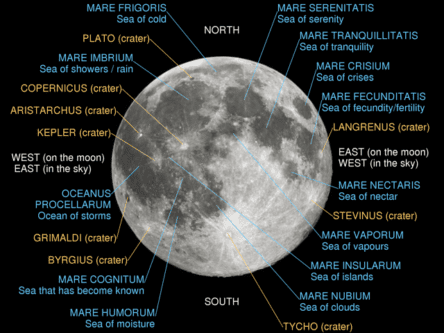
If I’ve said it once, I’ve said it a bazillion times: the moon is one of the most rewarding celestial objects you can observe with either a pair of binoculars or a small telescope. It’s big, it’s bright, it’s nearby, and its surface features offer some truly jaw-dropping vistas. Lava-filled impact basins, volcanic domes, craters, valleys, mountains and more await the backyard astronomer who yearns to explore other worlds in detail without having to leave behind all the safety and comforts of home.

Since this year’s International Observe the Moon Night falls on October 5th, I thought it would be a good opportunity for me to share with you one of my favorite lunar features. Wait, scratch that, I mean “three” of my favorite lunar features. But more on that in just a minute, first I want to tell you a bit more about International Observe the Moon Night (InOMN). InOMN is an annual, global event that celebrates the moon, lunar science and exploration, as well as our various cultural ties to the moon. It was first held back in 2010 at NASA’s Goddard Spaceflight Center and, since then, has been held each year, worldwide, in either September or October. The date is chosen to be centered around a fall first quarter moon, a good time of the year for those of us here in the Northern Hemisphere since it often means a respite from hot summer nights and because a partially illuminated moon greatly enhances the views of the lunar topography.
Here in the Little Rock area, the Central Arkansas Astronomical Society and Pinnacle Mountain State Park, will be hosting an InOMN event at the park’s visitor center on the night of October 5th from 7:00 P.M. to 10:00 P.M. It’s free and family friendly so please come out and enjoy exploring the moon and points beyond.
When and Where to Look
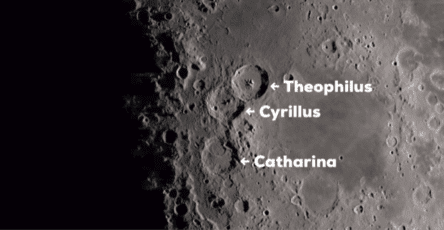
Okay, so what I want to direct your attention to this month is a spectacular chain of three lunar craters known as Theophilus, Cyrillus, and Catharina.
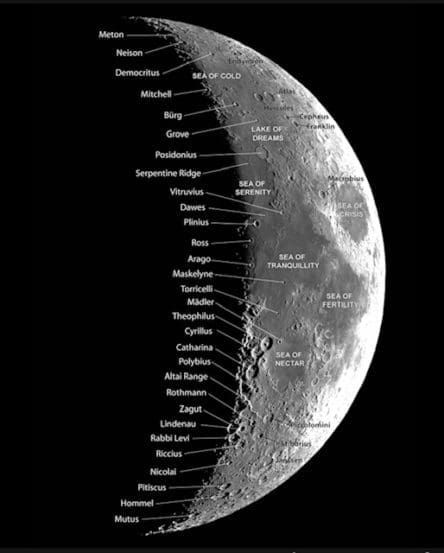
To find these three distinctive craters, use the accompanying image to locate Mare Nectaris (“Sea of Nectar), the crater trio lie right along its western edge.
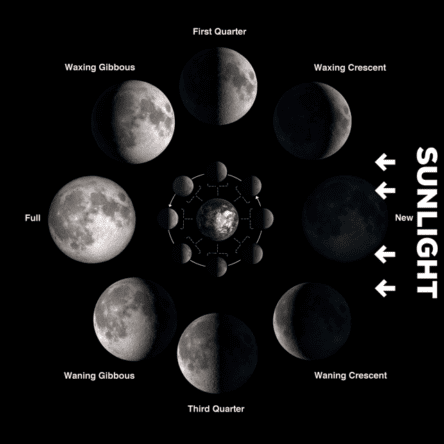
As the moon orbits around the Earth, it is constantly changing its position relative to both us and the Sun, as a consequence of this orbital motion, we see the moon go through a set of phases as the Sun illuminates different portions of the lunar surface. To go through a complete set of phases- from new moon to full moon and back again to new moon -takes 29.5 days and is the basis for our concept of a month. We call this lunar month a “lunation”, but if you want to talk like an astronomer, you can also call it a “synodic month”.
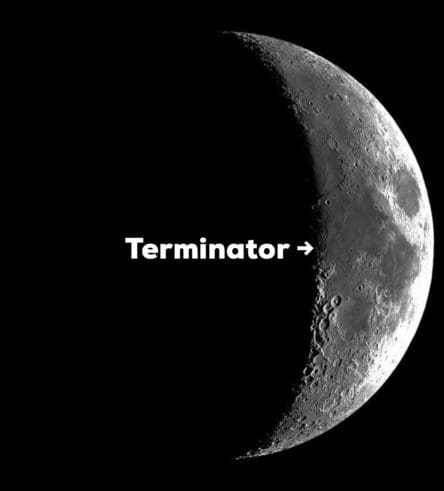
When we see the moon being partially lit as it goes through these phases, the line that divides the illuminated portions from the darkened portions is called the “terminator”. The terminator is literally the line that divides the night from the day on the moon and it is along this line that you really want to look while viewing lunar features with a telescope. Why? Because the sunlight is coming in at a shallow angle along the terminator and it creates dramatic shadows that throw craters and mountains into sharp relief. By the way, even though the moon is tidally locked with the Earth, always showing us one face, there is no “dark side of the moon”, perpetually shrouded in darkness, all areas of the moon receive equal amounts of day and night over the course of a lunation (sorry, Pink Floyd).
As the terminator advances from night to night, it reveals all new wonders for us to explore with binoculars or a telescope. If we saythat Day 0 is new moon (which we can’t see because it is too close tothe Sun) then Day 1 and Day 2 are when we first begin to glimpse a very thin crescent moon low in the western sky right after sunset. It is on Days 5 and 6 that you should seek out Theophilus, Cyrillus,
and Catharina as the terminator is just now bringing them into view. But they are still just as nice on Day 7 as well.
What You Are Seeing

Theophilus, Cyrillus, and Catharina are an example of a “crater chain”, or, in astronomer speak, a “catena”. You can get a crater chain in one of several ways. Take a look at this wonderful example known as Catena Davy, as seen by the crew aboard Apollo 12. This crater chain was formed after a weakly held together comet or asteroid strayed too close into the moon’s gravity field and got torn apart by tidal forces. Afterwards, the fragments slammed into the lunar surface in quick succession, creating the chain. We see this kind of thing in various places on the moon and even on other satellites and planets in the solar system. In fact, we were able to witness such an event first-hand back in 1994 when 21 fragments of Comet Shoemaker-Levy 9 (some fragments being over a mile in diameter) slammed into the atmosphere of Jupiter, creating a string of dark bruises as they punched their way through the cloud tops, lofting superheated plumes up into the planet’s stratosphere.
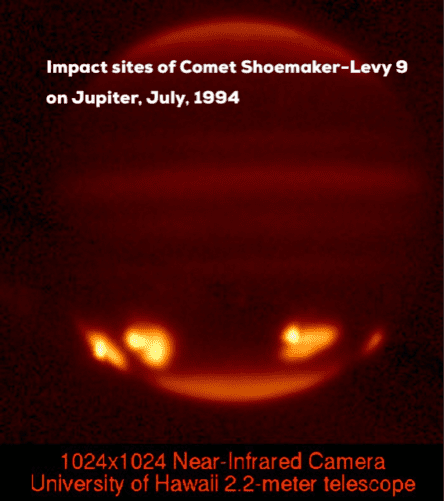
Other crater chains can be created from volcanic activity or from a process of secondary cratering. It’s the last method that accounts for the creation of this trio of craters. We can deduce that by observing that the craters all appear to be of vastly different ages. How do we know the ages of anything on the moon? We can assign fairly precise ages for the moon itself, as well as for many of its more prominent features, via radioisotope dating of the rocks brought back from the various Apollo missions. From this data we have determined that the moon is about 4.5 billion years old. The leading theory for its formation is that around this time, a celestial body the size of Mars impacted the young Earth at an oblique angle. The collision hurled material from both bodies out into space, which would eventually coalesce to form the moon. This is known as the “Giant Impact Hypothesis” and there are multiple lines of evidence to support it. It’s not a perfect model but it does explain a lot of what we observe about the makeup of both the moon and the Earth. Anyways, the infant moon would have been covered in a magma ocean, as it cooled, the lighter material, mainly aluminum and silicates, floated to the top and then cooled over time to form a crust. This is the light-colored stuff we see when we look up at the moon and it makes up the ancient lunar highlands.
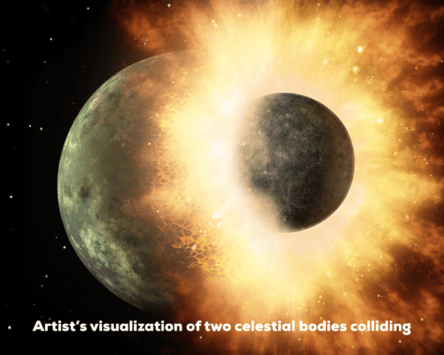
But around 4 billion years ago, the inner parts of the solar system got hammered with a barrage of asteroids and meteors during a time known as the Late Heavy Bombardment (LHB). The LHB occurred approximately from 4.1 to 3.8 billion years ago and is probably the result of the larger, outer planets undergoing a migration of sorts before finally settling into their current orbits. As this migration process took place, it stirred up the asteroid belt and sent a flood of large objects hurtling into the inner solar system. The moon got hit hard by many of these objects, some of which were so large that they punctured through the older crustal material. The large basins that formed from this process were later filled in with seas of lava, they eventually cooled to form the dark plains of the lunar lowlands that we see today and are known as “maria” (Latin for “seas”, the singular form is “mare”). With material gathered from the Apollo missions, we have determined that the maria are about 3 to 3.5 billion years old, so these lava plains are younger than the highland material. With no atmosphere to speak of on the moon and no plate tectonic activity, the weathering of impact craters and other features is a very slow process. In fact, erosion on the moon is estimated to occur at the glacial pace of about 1cm every 20 million years. Needless to say, craters will last a very long time on the moon unless they get overlain by other craters from fresh impacts. As a general rule, we can do relative dating of craters by looking at the amount of erosion that has taken place and by doing crater counts. The older surfaces of the moon have been exposed to impacts for a longer period of time, therefore, the older surfaces tend to have a higher number of craters than do the younger surfaces.
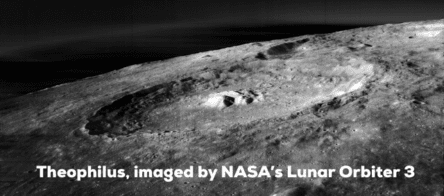
When you look at Theophilus you are immediately struck by the sharpness and complexity of its features compared to the other two. That and the fact that its southern rim overlaps Cyrillus tells us that Theophilus is the youngest crater in this chain. Theophilus, named for an ancient Greek cartographer, measures some 60 miles in diameter and is a spectacular sight in a small telescope. Pay attention to how well defined its rim is compared to the other two craters, note its terraced inner walls and its relatively flat floor and the eye-catching central mountain peaks. When the impactor that created Theophilus struck the lunar surface it was obliterated. But at the point of impact it sent out a shockwave that excavated the crater itself by melting the local rock and sending material straight up. When this melted material fell back inwards, it resurfaced the crater floor with lava. Later, the rock beneath the crater floor rebounded and pushed up the central peak of mountains that you see, rising some 2.7 miles up to the rim. Over the course of the lunation, note how its contours appear to change. While the floor of the crater was still fresh and molten, a section of the crater walls collapsed and sent a tidal wave of lava sloshing over the sides and spreading out to the crater’s north. With high magnification you can see this lava slosh for yourself.
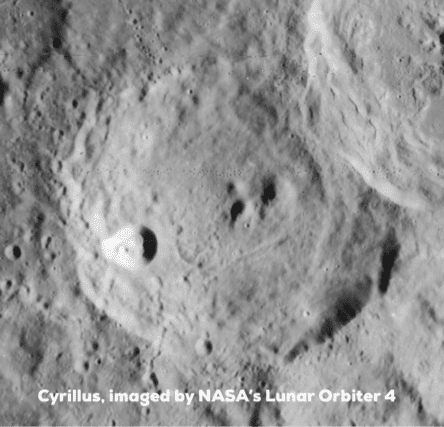
Cyrillus, named for St, Cyril, a 4th century theologian, is much worn and battered in comparison to Theophilus. Cyrillus’s edges are not nearly as well defined, its walls show a considerable amount of slumping, the central peak is worn down, and the crater floor is far from being smooth. If you look to the southwestern wall of the crater, you will even see a smaller, younger crater inside the older crater, this is Cyrillus A.

To the south of Cyrillus is Catharina, named for St. Catherine, a Greek theologian and philosopher. The two craters are connected by a large, broad valley that lends them a dumbbell-like appearance. Catharina is, if anything, even more beaten than Cyrillus, making it the oldest of the three craters. Numerous secondary impacts have nearly obliterated the crater while its walls and rim reveal a considerable amount of erosion. You may note that the floor of Catharina is much smoother than that of Cyrillus, this is probably due to excavated material from the secondary impacts burying its features.
I love looking at this crater chain and getting a real sense for the vast amounts of time and violence that have sculpted the moon’s surface over the eons. I can’t travel back in time to witness those events, but due to the moon’s tendency to preserve its history so well, and with just a little imagination, I almost feel as though I have. Hopefully you will too.
